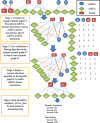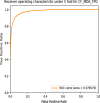Inferring miRNA-disease associations using collaborative filtering and resource allocation on a tripartite graph
- PMID: 34789252
- PMCID: PMC8600685
- DOI: 10.1186/s12920-021-01078-8
Inferring miRNA-disease associations using collaborative filtering and resource allocation on a tripartite graph
Abstract
Background: Developing efficient and successful computational methods to infer potential miRNA-disease associations is urgently needed and is attracting many computer scientists in recent years. The reason is that miRNAs are involved in many important biological processes and it is tremendously expensive and time-consuming to do biological experiments to verify miRNA-disease associations.
Methods: In this paper, we proposed a new method to infer miRNA-disease associations using collaborative filtering and resource allocation algorithms on a miRNA-disease-lncRNA tripartite graph. It combined the collaborative filtering algorithm in CFNBC model to solve the problem of imbalanced data and the method for association prediction established multiple types of known associations among multiple objects presented in TPGLDA model.
Results: The experimental results showed that our proposed method achieved a reliable performance with Area Under Roc Curve (AUC) and Area Under Precision-Recall Curve (AUPR) values of 0.9788 and 0.9373, respectively, under fivefold-cross-validation experiments. It outperformed than some other previous methods such as DCSMDA and TPGLDA. Furthermore, it demonstrated the ability to derive new associations between miRNAs and diseases among 8, 19 and 14 new associations out of top 40 predicted associations in case studies of Prostatic Neoplasms, Heart Failure, and Glioma diseases, respectively. All of these new predicted associations have been confirmed by recent literatures. Besides, it could discover new associations for new diseases (or miRNAs) without any known associations as demonstrated in the case study of Open-angle glaucoma disease.
Conclusion: With the reliable performance to infer new associations between miRNAs and diseases as well as to discover new associations for new diseases (or miRNAs) without any known associations, our proposed method can be considered as a powerful tool to infer miRNA-disease associations.
Keywords: Collaborative filtering algorithm; Infer miRNA-disease associations; Recommender systems; Resource allocation algorithm; miRNA-disease-lncRNA tripartite graph.
© 2021. The Author(s).
Conflict of interest statement
The authors declare that there is no competing interest in relation to the publication of this article.
Figures
References
-
- Shen Z, Zhang YH, Han K, Nandi AK, Honig B, Huang DS. MiRNA-disease association prediction with collaborative matrix factorization. Complexity. 2017;2017.
Publication types
MeSH terms
Substances
LinkOut - more resources
Full Text Sources




